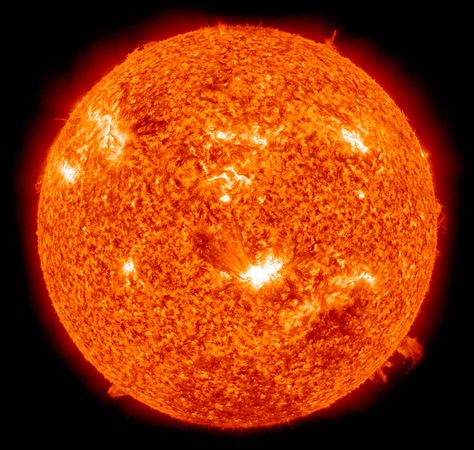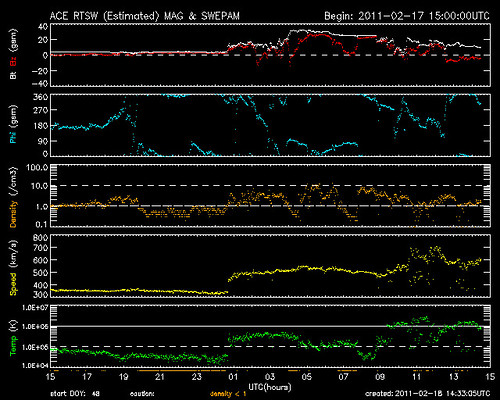I find it hard to believe our Sun is still shining above the continual gloom that has covered central England for much of this winter but not only is it still there, it’s starting to wake up from an unusually quiet period and the many space missions studying the Sun are poised to track its every move. Amongst this fleet of are the twin spacecraft of the NASA STEREO mission. These spacecraft are in Earth-like orbits, one drifting ahead of the Earth and the other lagging behind in order to get a 3D perspective of the solar surface and any mass ejections that head into space. The UK provided the detector systems and a pair of instruments – the Heliospheric Imagers – for this mission. The Heliospheric Imagers are wide-field visible light cameras that are mounted on the side of each spacecraft in order to image the Sun-Earth line. In this way, anything in the solar wind that is heading towards Earth can be tracked all the way to our planet.

Our Sun is a variable star, undergoing an activity cycle that has a peroid of around eleven years on average. This cycle is driven by the differential rotation of this fluid body which twists and tangles the embedded magnetic fields, storing energy that can be released as solar flares (bright flashes of light – usually at extreme ultra violet and x-ray wavelengths) and coronal mass ejections (CMEs, vast eruptions of material). While flares and CMEs are related phenomena, they do not necessarily occur at the same time. Like earthquakes and volcanoes, they are related but not the same thing.
The reason we want to know about Earth-directed CMEs is that they can damage any of the satellites that represent an increasingly large investment in space-based technology as well as induce unexpected electrical surges in ground-based power grids.
Study of the influence of the Sun on our space environment and the Earth’s technological systems has become known as ‘space weather’ and STEREO is at the forefront of this field.
On February 14th 2011, a bright (X class) flare occurred which was accompanied by a modest mass ejection on the Earth-facing side of the Solar disk.
The CME (sometimes referred to as a solar storm) was immediately identified as Earth-directed and the STEREO HI group, along with the enthusiastic support of the citizen science project Solar Stormwatch (www.solarstormwatch.com) were able to make predictions that the storm would arrive at Earth in the early hours of February 18th.
The Stormwatch alert warned of a storm heading in a direction that would take it within 3 degrees of Earth and that it would arrive at around 9 UT (GMT) on the 18th February. Just before 01:00 UT on the 18th, the ACE spacecraft (which sits around a million miles upstream of the Earth in the solar wind), saw a simultaneous increase in magnetic field strength (Bt – the white line in the plot below)), solar wind speed (yellow) , density (orange) and temperature (green). You need to add on about an hour to these times to get the arrival time at Earth. After this, the CME washed over the Earth for several hours.
The ACE data for the 18th looked like this;

The heliospheric imagers on the STEREO spacecraft ’see’ a solar storm by imaging sunlight that is scattered off the hot cloud of plasma. The more particles there are in the solar wind, the brighter it looks in our cameras. The leading edge of the storms we observe therefore corresponds with the sudden jump in solar wind density seen by ACE just before 01:00.
So, did this storm cause any auroral activity? Well I’d be surprised if there wasn’t any. The efficiency with which the solar wind can dump energy into our atmosphere depends on the orientation of the solar wind’s magnetic field with respect to the Earths. If it has a northward component (Bz, the red line in the ACE plots, is positive or greater than 0) then the solar wind and Earth’s fields are similar and, like laboratory magnets, like poles repel each other and not much interaction occurs (there may be some if the magnetic field is complex, I’m just talking about the idealised situation here). If there is a southward component however (Bz negative, less than 0) the two fields can connect (space scientist call this magnetic reconnection) allowing the solar wind to enter the Earth’s magnetic field over the north and south poles where it accelerates particles into the Earth’s atmosphere, exciting the gasses there which then glow – generating the aurora.
The longer and more extreme the period of southward Bz, the more likely there is to be auroral activity and the further equatorward this activity is likely to occur.
If you look back at the snapshot of data from the ACE spacecraft (top panel, red line), you will see that initially the storm had a northward component (+ve Bz) but that this subsequently swung southwards indicating that there may be auroral activity. If you want to keep an eye on the real-time ACE data, you can access the feed at;
http://www.swpc.noaa.gov/ace/MAG_SWEPAM_24h.html
The skies above me in Oxfordshire were once again their uniform grey colour but for those with clear skies, there may well have been some aurora during the subsequent few days.
Thanks to missions like STEREO we are able to improve our predictions of CME arrivals at Earth but we are a long way from making forecasts as in-depth as weather forecasts on Earth. As a science, space weather is currently at the same point of development that meteorology was back in the 1950s. As the Sun wakes from its recent slumber, we will be studying every event in detail and using this new information to improve future forecasts.
Chris.